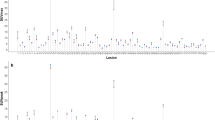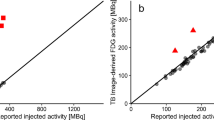Abstract
Objectives
The aim of this study was to assess variation of qualitative and quantitative PET/CT image quality parameters with acquisition time, injection activity and body mass for a representative group of adults undergoing whole-body PET/CT imaging.
Methods
PET scan data from sixty patients were reconstructed with a scan time of 1, 2 and 3 min/bed position. These images were visually scored and three quantitative parameters were calculated: noise equivalent counts per axial length (NECpatient), noise equivalent count density (NECdensity) and liver signal to noise ratio (liver SNR). The ability of the three quantitative parameters to discriminate qualitative image quality was assessed using ROC analysis.
Results
The quantitative parameters were shown to discriminate images of good/excellent quality from those of poorer image quality with a high degree of accuracy (ROC area >0.9); further, NECpatient had significantly higher discrimination than either NECdensity or liver SNR (ROC area = 0.97).
Conclusions
NECpatient, NECdensity and liver SNR all have high discrimination for qualitatively assessed PET image quality. NECpatient in particular is an effective objective indicator of patient image quality, which will help to assess and standardise scan protocols for purposes such as multi-centre research trials.




Similar content being viewed by others
References
Boellaard R. Standards for PET image acquisition and quantitative data analysis. J Nucl Med. 2009;50:11S–20S.
Buckler AJ, Boellaard R. Standardization of quantitative imaging: the time is right, and 18F-FDG PET/CT is a good place to start. J Nucl Med. 2011;52:171–2.
Delbeke D, Coleman RE, Guiberteau MJ, Brown ML, Royal HD, Siegel BA, et al. Procedure guideline for tumor imaging with 18F-FDG PET/CT 1.0. J Nucl Med. 2006;47:885–95.
Boellaard R, O’Doherty MJ, Weber W, Mottaghy FM, Lonsdale MN, Stroobants SG, et al. FDG PET and PET/CT: EANM procedure guidelines for tumour PET imaging: version 1.0. Eur J Nucl Med Mol Imaging. 2010;37:181–200.
Fukukita H, Senda M, Terauchi T, Suzuki K, Daisaki H, Matsumoto K, et al. Japanese guideline for the oncology FDG-PET/CT data acquisition protocol: synopsis of Version 1.0. Ann Nucl Med. 2010;24:325–34.
Brown C, Dempsey MF, Gillen G, Elliot AT. Investigation of 18F-FDG 3D mode PET image quality versus acquisition time. Nucl Med Commun. 2010;31:254–9.
Masuda Y, Kondo C, Matsuo Y, Uetani M, Kusakabe K. Comparison of imaging protocols 18F-FDG PET/CT in overweight patients: optimizing scan duration versus administered dose. J Nucl Med. 2009;50:844–8.
Mizuta T, Senda M, Okamura T, Kitamura K, Inaoka Y, Takahashi M, et al. NEC density and Liver ROI S/N ratio for image quality control of whole body FDG-PET scans: comparison with visual assessment. Mol Imaging Biol. 2009;11:480–6.
Watson CC, Casey ME, Bendiem B, Carney JP, Townsend DW, Eberl S, et al. Optimizing injected dose in clinical PET by accurately modelling the count rate response functions specific to individual patient scans. J Nucl Med. 2005;46:1825–34.
Accorsi R, Karp JS, Surti S. Improved dose regimen in pediatric PET. J Nucl Med. 2010;51:293–300.
Chang T, Chang G, Kohlmeyer S, Clark JW, Rohren E, Mawlawi OR. Effects of injection dose, BMI and scanner type on NECR and image noise in PET imaging. Phys Med Biol. 2011;56:5275–85.
Chang T, Chang G, Clark JW, Diab RH, Rohren E, Mawlawi OR. Reliability of predicting image signal-to-noise ratio using noise equivalent count rate in PET imaging. Med Phys. 2012;39:5891–900.
Perkins A, Stearns C, Chapman J, Kolthammer J, Williams JJ, Casey M. NEMA Standards Publication NU 2-2007: Performance measurements of positron emission tomographs. Rosslyn USA: National Electrical Manufacturers Association (NEMA);2007.
Lois C, Jakoby BW, Long MJ, Hubner KF, Barker DW, Casey ME, et al. An assessment of the impact of incorporating time-of-flight information into clinical PET/CT imaging. J Nucl Med. 2010;51:237–45.
Kamimura K, Nagamachi S, Wakamatsu H, Higashi R, Ogita M, Ueno S, et al. Associations between liver (18)F fluoro-2-deoxy-d-glucose accumulation and various clinical parameters in a Japanese population: influence of the metabolic syndrome. Ann Nucl Med. 2010;24:157–61.
Bettinardi V, Presotto L, Rapisarda E, Picchio M, Gianolli L, Gilardi MC. Physical performance of the new hybrid PET/CT Discovery 690. Med Phys. 2011;38:5394–411.
Acknowledgments
The authors wish to thank the staff of the Nuclear Medicine Department of St. James' University Hospital (Leeds, UK), especially Fiona Ware, Karen Askew and Sharon Parkinson. No potential conflicts of interest were disclosed.
Author information
Authors and Affiliations
Corresponding author
Rights and permissions
About this article
Cite this article
McDermott, G.M., Chowdhury, F.U. & Scarsbrook, A.F. Evaluation of noise equivalent count parameters as indicators of adult whole-body FDG-PET image quality. Ann Nucl Med 27, 855–861 (2013). https://doi.org/10.1007/s12149-013-0760-2
Received:
Accepted:
Published:
Issue Date:
DOI: https://doi.org/10.1007/s12149-013-0760-2




